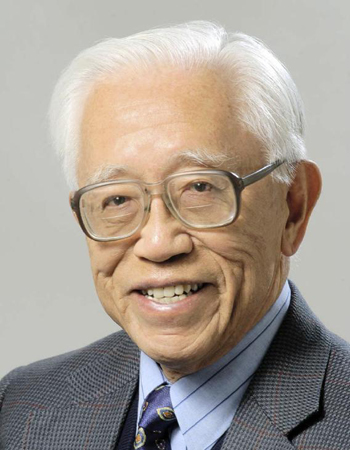Ernest S. Kuh (1928 – 2015): pioneer in electronic circuit theory and EDA
As a devoted Michigan alumnus, he established the Ernest and Bettine Kuh Distinguished Faculty Scholar Award in Electrical and Computer Engineering at the University of Michigan.

 Enlarge
Enlarge
Ernest S. Kuh (BSE EE ’49), pioneer in electronic circuit theory and electronic design automation, passed away peacefully at his home on June 27, 2015 at the age of 86. Prof. Kuh also served as department chair and dean at UC-Berkeley, where he spent most of his career as a faculty member. As a devoted Michigan alumnus, he established the Ernest and Bettine Kuh Distinguished Faculty Scholar Award in Electrical and Computer Engineering at the University of Michigan.
Before coming to the United States in December of 1947, Prof. Kuh studied electrical engineering at Shanghai Jiao Tong University between the years 1945-47. He earned his BSE degree from Michigan in electrical engineering in 1949. Recalling his time at Michigan, Prof. Kuh said he found a lively Chinese student association, and felt welcomed by the American students.
Prof. Kuh received his master’s degree from MIT in 1950, and his PhD degree from Stanford University in 1952. After graduation, he accepted a position at AT&T Bell Labs, at that time considered one of the best places in the country for research. He was only the second Chinese hired at the company. He stayed for four years before accepting a position at the University of California, Berkeley in 1956.
His research led to a seminal paper on state-variable approaches to network analysis in 1965, and textbooks on circuit theory and synthesis that were widely taught in classrooms for two decades. He was President of the IEEE Society of Circuits and Systems (as it is now called) in 1972, and was instrumental in changing the name from the Group on Circuit Theory to its current name, effective 1973.
Prof. Kuh served as Chair of the EECS Department (1968-72) at Berkeley, and then Dean of Engineering (1973-80) at UC Berkeley. He was named the William S. Floyd Professor in Engineering in 1990. As Dean, he developed the Berkeley Industrial Liaison Program, and his interactions with industry helped guide his change in research focus to the computer-aided design of integrated circuits, also called electronic design automation (EDA). He served on the board of ECAD, founded in 1982, which would become Cadence Design Systems. At this time, computer-aided design was in the early stages of moving from mechanical to electronic, and Prof. Kuh was instrumental in the transition. He received the EDA’s highest award, the Phil Kaufman Award, in 1998. One of his early doctoral students would go on to receive the same award in 2002.
Prof. Kuh was inducted into the Silicon Valley Hall of Fame in 2008 and has received numerous additional awards and honors, including the IEEE Education Medal, the Kirchhoff Award, the IEEE Circuits & Systems Society Award, and the ASEE Lamme Medal. At Michigan, he received the U-M Distinguished Alumnus Award, and the U-M College of Engineering Medal. He is a fellow of IEEE and AAAS, and a member of the National Academy of Engineering.
Prof. Kuh touched the lives of several Michigan faculty over the years. He served as a mentor and source of inspiration for Prof. Pinaki Mazumder since his days as an assistant professor at Michigan. Prof. Mazumder wrote a paper about VLSI cell placement that captured the attention of Prof. Kuh, much to his delight. “Ever since I have valued the feedback he had provided to me regarding my research activities,” said Prof. Mazumder: “He was the most renowned and decorated professor in VLSI design automation, and he was an inspiration to me.”
Prof. Tony Grbic, recipient of the Ernest and Bettine Kuh Distinguished Faculty Scholar Award, said, “Prof. Kuh’s career and foundational work in circuit theory and computer-aided design is inspiring, and I was proud to carry the endowed associate professorship that bears his name. It was great to meet him at the reception where I received the Ernest and Bettine Kuh Distinguished Faculty Scholar Award. He was warm, funny and very supportive of my work in metamaterials. He took the time to talk over the phone a year after I received the award, asking questions about the research directions I was pursuing, and offering words of encouragement. The generous gift by Prof. Ernest Kuh and his wife Ms. Bettine Kuh offered me added research freedom, and helped support a new line of research.”
“Prof. Ernie Kuh left a remarkable legacy of pioneering research, highly-respected Ph.D. students, and administrative excellence,” said Khalil Najafi, Schlumberger Professor of Engineering and Chair of Electrical and Computer Engineering. “We are proud to count him as one of Michigan’s Leaders and Best, and are grateful that his name will be with us forever thanks to his and Bettine’s generous gift. On behalf of the department, we offer our sincere condolences to his family, friends, and loved ones.”
An event to celebrate the life of Ernest Kuh is being planned for September 2015, in California.
Prof. Ernest Kuh [In Memoriam], IEEE Circuits and Systems Magazine, Vol. 15, issue 4, pp. 4-11. [PDF]
Ernest and Bettine Kuh honor ECE with the Ernest and Bettine Kuh Distinguished Faculty Scholar Award
“Interconnects for Signal Processing” – Lecture by Prof. Ernest S. Kuh, delivered April 26, 2012 at the University of Michigan. In the lecture, Prof. Kuh also spoke about his career.
Ernest S. Kuh, Berkeley Engineering professor and dean emeritus, 1928–2015
 MENU
MENU 
